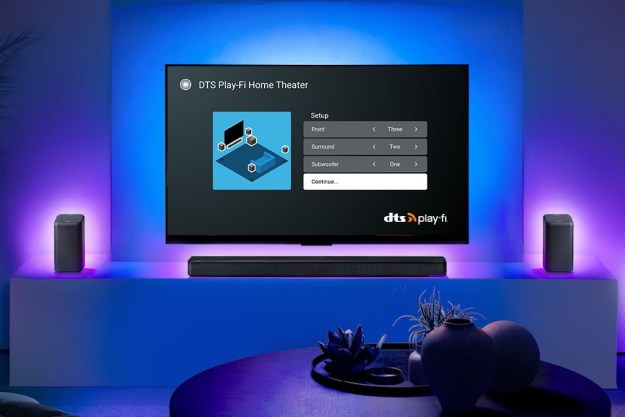The trouble with building an over-the-top, no-holds-barred A/V receiver is that it’s tough to follow up with something new the next year — you basically have to stick a new number on the same black box. Yamaha’s been in this pickle for a few years now with its premium Aventage line — not much has changed in the A/V receiver world since we first reviewed the RX-A3010 back in 2011 (unless you count 4K pass-through). But now that Dolby Atmos surround is available for home theaters, Yamaha’s Aventage line has some new bells and whistles to brag about. Feast your eyes (and ears) on the RX-A3040, Yamaha’s flagship, Dolby Atmos-ready A/V receiver.
For the hearty price of $2000, the RX-A3040 delivers all of the audiophile components and build quality we’ve come to expect from the line, with the added ability to decode Atmos surround and drive Atmos speakers, be they in-ceiling speakers, or Atmos-enabled speakers like the Andrew Jones speaker package we’re currently using here at Digital Trends.
The catch is, the RX-A3040 isn’t simply “Atmos ready,” out of the box. In order to tap into all that next-gen surround awesome, you’ll need to perform a firmware update — a task that’s a little easier said than done. You see, the RX-A3040 doesn’t allow firmware updates from its on-screen guide like many competing models do. Instead, a series of coordinated button presses must be executed from the receiver’s front panel, and if you don’t read Yamaha’s guide (which is available at the company’s website here) you might just mess the whole thing up and have to start over. Once the update is initiated, plan on waiting around for a while. With a strong Wi-Fi connection, the update took about 20 minutes for us.
Once the update is complete you’ll want to pay close attention to that guide (or just watch our video, we’ll show you how) because it’s easy to get confused along the way. You’ll be tapping the receiver’s “presence” channels for the Atmos speakers, and it isn’t immediately apparent that you’re doing the right thing as you go about the setup process.
Speaking of the setup process: Yamaha’s YPAO auto-setup routine once again mis-read our speaker’s proper size and crossover settings, but, as usual, nailed the distance and level settings. This is typical of most automated systems — not just Yamaha’s — so we weren’t surprised. As always, we suggest running auto setup, then fixing what’s wrong. It’s still easier than busting out a tape measure and decibel meter. We should also note we disabled the parametric EQ settings and found the sound to be superior.
Aside from those complaints, we’re really enjoying the RX-A3040. It’s got a lot of muscle so distortion-free, dynamic playback is no problem for this receiver, even with fairly demanding soundtracks and speakers. If if you’re a fan of that lively Yamaha sound, this receiver delivers it with class — we think it is a perfect match for more “laid back” speakers.
Check out our video and let us know what you think. With competition like Pioneer’s Elite SC-79 receiver in competition, what do you think of Yamaha’s latest?
Editors' Recommendations
- Samsung launches its flagship Dolby Atmos soundbar with discounted prices
- Amazon Prime Video makes Dolby Vision, Atmos a paid upgrade
- Samsung’s new Dolby Atmos wireless speaker doubles as a picture frame
- Bose’s new flagship Dolby Atmos soundbar brings AI smarts to the dialogue problem
- Sennheiser’s Ambeo Soundbar Mini is a pricey, bedroom-sized Dolby Atmos speaker





